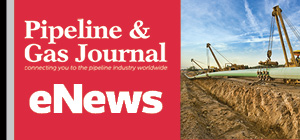February 2025, Vol. 252, No. 2
Features
Operator Challenges: Improving Safety, Efficiency in Pipeline Operations
By Steven John Cumper, Managing Director, Medshop Group
(P&GJ) — The oil and gas industry faces several critical challenges in its pipeline operations. It must somehow balance safety, efficiency, and environmental responsibility while remaining efficient and profitable.
Oil and gas professionals need to be vigilant about potential hazards while striving to optimize performance and efficiency. This article explores critical safety and efficiency considerations and outlines best pipeline maintenance and operations practices.
Safety is critical in the oil and gas industry, as even minor incidents can have severe consequences for workers, local communities, and the environment. In 2022, there were 614 pipeline incidents, which resulted in 12 fatalities and 61 injuries, according to the U.S. Pipeline and Hazardous Materials Safety Administration. The statistics for 2022 were typical.
These incidents highlight the importance of robust safety protocols for oil and gas operations. Emergency preparation is essential and includes having well-stocked first aid kits readily available at all pipeline facilities and sites. The contents of these first-aid kits should comply with industry standards and best practices. First aid supplies and training should also be tailored to each site's specific hazards.
Other key elements that define a strong safety culture in oil and pipeline operations include a leadership commitment to ongoing training and effective communication. Leadership must demonstrate a genuine commitment to safety beyond simply enforcing the bare minimum standards to comply with safety regulations.
Regular training reinforces safety protocols and ensures that all employees know the best practices and procedures to mitigate risks and how to respond to emergencies.
Technology should be leveraged to enhance safety via innovative solutions such as advanced AI-powered monitoring systems analyzing real-time data to allow operators to take swift, preemptive action against potential hazards. Corrosion and leaks can cause severe problems in pipeline operations, but early detection of these issues can significantly reduce risks, along with using automated shutoff valves to prevent significant spills and leaks.
Maintenance Hazards
Pipeline workers face numerous potential dangers on the job. Some of the most significant hazards include:
- Exposure to hazardous materials, gases, and chemicals
- Fire and explosion risks, particularly in confined spaces
- Falls and slips, especially when working at a height
- Struck-by injuries from heavy equipment and vehicles
- Electrical hazards
- Trenching and excavation accidents
Workers in the oil and gas industry face an array of hazards that demand constant vigilance and proactive safety measures. From exposure to hazardous materials and the ever-present risk of fires and explosions to the dangers of falls, heavy machinery, and electrical hazards.
Pipeline workers navigate a high-risk environment in their daily jobs. However, the industry can mitigate these dangers by implementing comprehensive safety protocols and fostering a culture of safety awareness.
It is crucial for companies and workers to collaborate in improving safety standards and practices to protect the workforce and critical infrastructure. As the industry evolves with advanced new technology, so must its approach to safety challenges and creating a safer working environment.
Mitigating Risks
Comprehensive safety programs are essential for protecting workers and assets in the oil and gas industry. Key elements of any effective pipeline safety strategy should include:
- Thorough and ongoing risk assessments and hazard identification processes.
- Implementation of safety management systems. Comprehensive safety programs can reduce pipeline incidents by up to 61%.
- Corrosion is responsible for 15-20% of all pipeline incidents, so regular inspection and maintenance of pipeline infrastructure will prevent corrosion-related failures.
- Robust emergency response plans and drills as part of an ongoing safety training program for all personnel
- Advanced monitoring and leak detection technologies, such as drones for pipeline inspections, can reduce inspection costs by up to 50% and enhance safety and efficiency.
- Strict adherence to industry regulations, guidelines, and standards as part of a systematic approach to continuously improving safety performance.
The oil and gas pipeline industry faces numerous hazards requiring a systemic safety management approach. Implementing comprehensive safety programs, including risk assessment, infrastructure maintenance, ongoing training, and technology adoption, can significantly reduce the likelihood, severity, and impact of accidents and injuries.
Statistics demonstrate that adopting technology such as drones can substantially reduce incidents and produce cost savings in inspection processes. Prioritizing safety through these approaches protects workers and assets while enhancing operational efficiency and regulatory compliance. Maintaining a strong commitment to safety will be crucial for sustainable and responsible operations in the oil and gas pipeline industry.
Companies should implement a comprehensive safety management system that follows the RP 1173 standard to ensure compliance with safety regulations. This standard, published by the American Petroleum Institute, establishes a framework for pipeline safety management systems that integrates all aspects of pipeline operation and includes regular risk assessments and preventive measures to mitigate them.
Conclusion
For many years, the pipeline industry has grappled with the tricky balancing act of keeping operations safe while running efficiently and profitably. Smart oil and gas companies don't see incorporating safety as a problem but rather as an opportunity to make things run smoother and more efficiently.
New technology is changing the safety game with fancy leak detectors and drones using AI to spot problems early, allowing companies to fix issues before they become major headaches.
The rules are changing, too. New laws are cracking down on leaks and keeping a closer eye on pipelines. Companies must stay ahead of these new regulations and guidelines without slowing down their work. However, new regulations can also mean new opportunities.
For example, oil and gas pipeline operators are currently working on ways to move carbon dioxide through pipes to help fight climate change. The companies that'll come out on top are the ones that can roll with the punches and embrace new technology while staying ahead of the regulations and making smart choices based on data.





Comments